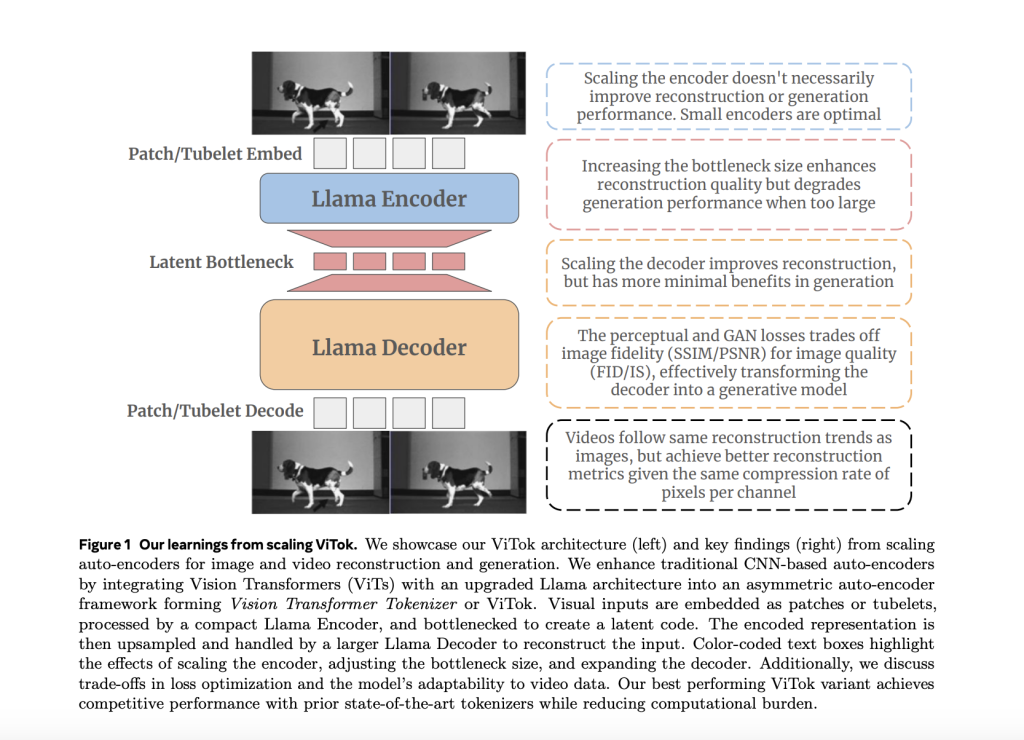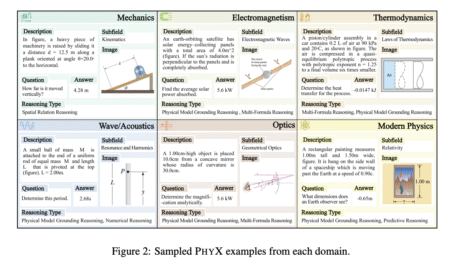

Modern image and video generation methods rely heavily on tokenization to encode high-dimensional data into compact latent representations. While advancements in scaling generator models have been substantial, tokenizers—primarily based on convolutional neural networks (CNNs)—have received comparatively less attention. This raises questions about how scaling tokenizers might improve reconstruction accuracy and generative tasks. Challenges include architectural limitations and constrained datasets, which affect scalability and broader applicability. There is also a need to understand how design choices in auto-encoders influence performance metrics such as fidelity, compression, and generation.
Researchers from Meta and UT Austin have addressed these issues by introducing ViTok, a Vision Transformer (ViT)-based auto-encoder. Unlike traditional CNN-based tokenizers, ViTok employs a Transformer-based architecture enhanced by the Llama framework. This design supports large-scale tokenization for images and videos, overcoming dataset constraints by training on extensive and diverse data.
ViTok focuses on three aspects of scaling:
- Bottleneck scaling: Examining the relationship between latent code size and performance.
- Encoder scaling: Evaluating the impact of increasing encoder complexity.
- Decoder scaling: Assessing how larger decoders influence reconstruction and generation.
These efforts aim to optimize visual tokenization for both images and videos by addressing inefficiencies in existing architectures.

Technical Details and Advantages of ViTok
ViTok uses an asymmetric auto-encoder framework with several distinctive features:
- Patch and Tubelet Embedding: Inputs are divided into patches (for images) or tubelets (for videos) to capture spatial and spatiotemporal details.
- Latent Bottleneck: The size of the latent space, defined by the number of floating points (E), determines the balance between compression and reconstruction quality.
- Encoder and Decoder Design: ViTok employs a lightweight encoder for efficiency and a more computationally intensive decoder for robust reconstruction.
By leveraging Vision Transformers, ViTok improves scalability. Its enhanced decoder incorporates perceptual and adversarial losses to produce high-quality outputs. Together, these components enable ViTok to:
- Achieve effective reconstruction with fewer computational FLOPs.
- Handle image and video data efficiently, taking advantage of the redundancy in video sequences.
- Balance trade-offs between fidelity (e.g., PSNR, SSIM) and perceptual quality (e.g., FID, IS).
Results and Insights
ViTok’s performance was evaluated using benchmarks such as ImageNet-1K, COCO for images, and UCF-101 for videos. Key findings include:
- Bottleneck Scaling: Increasing bottleneck size improves reconstruction but can complicate generative tasks if the latent space is too large.
- Encoder Scaling: Larger encoders show minimal benefits for reconstruction and may hinder generative performance due to increased decoding complexity.
- Decoder Scaling: Larger decoders enhance reconstruction quality, but their benefits for generative tasks vary. A balanced design is often required.
Results highlight ViTok’s strengths in efficiency and accuracy:
- State-of-the-art metrics for image reconstruction at 256p and 512p resolutions.
- Improved video reconstruction scores, demonstrating adaptability to spatiotemporal data.
- Competitive generative performance in class-conditional tasks with reduced computational demands.

Conclusion
ViTok offers a scalable, Transformer-based alternative to traditional CNN tokenizers, addressing key challenges in bottleneck design, encoder scaling, and decoder optimization. Its robust performance across reconstruction and generation tasks highlights its potential for a wide range of applications. By effectively handling both image and video data, ViTok underscores the importance of thoughtful architectural design in advancing visual tokenization.
Check out the Paper. All credit for this research goes to the researchers of this project. Also, don’t forget to follow us on Twitter and join our Telegram Channel and LinkedIn Group. Don’t Forget to join our 65k+ ML SubReddit.
 Recommend Open-Source Platform: Parlant is a framework that transforms how AI agents make decisions in customer-facing scenarios. (Promoted)
Recommend Open-Source Platform: Parlant is a framework that transforms how AI agents make decisions in customer-facing scenarios. (Promoted)
The post Researchers from Meta AI and UT Austin Explored Scaling in Auto-Encoders and Introduced ViTok: A ViT-Style Auto-Encoder to Perform Exploration appeared first on MarkTechPost.
Source: Read MoreÂ




